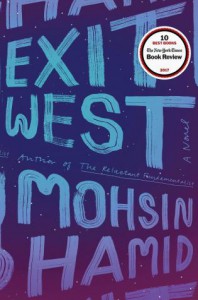Wonderful

Nov 2017 UC Book Club Read
When I opened today’s copy of the New York Times, I was greeted with stories about refugees to Europe and the Rohingya massacre/refugees. This isn’t counting the almost constant debate in the US about DACA and illegal immigrants to the country who are in many cases refugees as well. Therefore, the topic of Hamid’s book is hardly surprising.
On the surface, Hamid’s book with its beautiful prose is about two refugees, their life before they are forced to flee and their life after. Nadia and Saeed are both from an unnamed, presumably, Middle Eastern/Asian/African country that succumbs to a civil war. Naida appears, at first, to be conventional, but this is shown to be simply a pose to keep herself safe. Saeed too isn’t quite what he appears to be. Eventually, when war breaks out, the two must leave their home and travel to Europe.
And this is the interesting part of the book. Hamid’s book is magic realism (or fantasy depending on which term you prefer. For me, magic realism is fantasy), so the journey to Europe and another points West is, quite frankly, a door. Hence, the title that sounds like a stage direction. The use of doors as portals not only removes the need for horrific crossing stories that perhaps, sadly, we have become too immune to. Additionally, doors are portals, powerful symbols of change.
And doors work many different ways. They are not one way.
This seems in many ways to be a main point of the novel. The story of Saeed and Nadia as they adjust and change to the circumstances in which they find themselves is interwove with that of people from the West as they find the doors. In part this is brilliant. The first use of the door is creepy, and literally a WTF moment. Hamid might have a future in genre writing considering how well done it is. But there is also a brilliant moment of the door that is simply a woman on a tram/train who realizes that her fellow passengers are not necessary her fellow people. That small sequence is so well done that Hamid should win prize after prize for that passage alone.
In part, Hamid seems to be arguing that one truth of humanity is that we all are (or will be) a refugee – whether in the newsworthy form of Nadia and Saeed or simply in the quieter ways of the other characters in the novel. There is some truth in this statement, and this book challenges us to change how we look at refuges and how we define them.








